
Written by Venturz Editorial Team,
Category: Marketing and sales

Step into the inbox arena where transactional emails and marketing emails engage in a unique dance of purpose.
Transactional emails facilitate specific actions, like purchase receipts, while marketing emails promote products/services, engaging recipients for brand awareness and sales.
Let's unravel the contrasts between these digital messengers as we explore their distinct roles, impacts, and the intriguing world they create in the realm of online communication.

Transactional emails are the unsung heroes of your inbox, delivering crucial information triggered by your actions. Think order confirmation emails, email receipts, password resets, and shipping notifications.
They're the reliable messengers ensuring you're in the loop, offering a seamless and personalized user experience. Unlike flashy promotions, these emails are all about delivering value, like containing an unsubscribe link and not selling it.

Marketing emails are the charismatic showstoppers of your inbox, designed to dazzle and entice. They're the ones promoting new products, exclusive offers, welcome emails, customer satisfaction, and company updates.
With eye-catching visuals and persuasive language, marketing emails aim to captivate your attention and nudge you toward a purchase or engagement. It's all about making that sale while leaving a memorable impression.

When it comes to the email universe, both transactional messages and marketing emails are like two sides of the same coin.
Yet, beneath their digital exteriors, they serve vastly different purposes and wield unique powers.
Let's delve into the key differences and disparities between a marketing and transactional email:
These emails are the unsung heroes of your digital communication. Triggered by your actions, like signing up for a service, making a purchase, or requesting a password reset, they deliver critical information.
Their primary purpose is to provide timely updates, confirmations, support requests, and relevant details related to your interactions with a service or platform.
Here come the charismatic showstoppers of your spam folder: bulk email! Marketing emails are strategically crafted to engage, entice, and influence.
Their primary objective is to market products, services, or promotions. These emails are designed to captivate your attention, stimulate interest, and ultimately drive actions that align with the sender's own social media marketing strategy and goals.
Simplicity reigns supreme in transactional emails. Their design is typically straightforward and utilitarian. The focus is on delivering information concisely and effectively without distracting frills.
Clean layouts and clear typography ensure that you can quickly access and understand the information.
Prepare for a visual feast! Marketing emails prioritize aesthetics and visual impact. They're dressed to impress with eye-catching graphics, compelling images, and attention-grabbing colors.
The goal is to not only convey the message but also evoke emotions and curiosity through visually appealing designs.
While transactional emails may include subtle calls to action (such as confirming an order or verifying an account), their emphasis is on guiding you through a specific process.
These emails are transaction-centric, aiming to help you complete a particular action without distraction.
The call to action takes center stage in marketing emails. From prominent buttons to persuasive language, these emails encourage you to take a specific action, whether it's making a purchase, signing up for a webinar, or exploring a new product.
Their success hinges on compelling you to engage beyond just reading the message.
Personalization in transactional emails is all about your actions. These automated emails respond directly to your specific interactions, tailoring information to your individual needs.
They create a sense of efficiency and relevance by providing you with exactly what you need, when you need it.
Personalization in marketing emails often extends beyond actions to encompass your preferences and behaviors.
Brands use data to curate content and offers that align with your past interactions, making the message feel more tailored to your interests and increasing the chances of engagement.
The frequency of transactional emails is directly tied to your actions. You trigger them, and they respond with the relevant information.
Their appearance in your recipient's inbox is more event-driven, occurring when you initiate a specific interaction.
Marketing emails have a more consistent presence. Brands often send these promotional emails regularly as part of their outreach and engagement strategies.
Their goal with traditional marketing email is to maintain brand awareness, provide updates, and prompt interactions, ensuring that customer experience with the brand stays top-of-mind.
These emails are the straight talkers of the email universe. They cut to the chase, delivering essential information without unnecessary fluff.
Whether it's a shipping update or a password reset, the content of invoice email is direct and purposeful, catering to your immediate needs.
Content takes a creative twist in marketing emails. Crafted with persuasive language and engaging narratives, they tell stories that resonate with your desires.
Whether it's a compelling product description, an enticing offer, or a relatable brand story, these examples of marketing emails aim to ignite your interest and spark action.
Let's delve into the world of these email titans through real-life email examples that showcase their unique roles and impacts.
A prime example of a transactional email is the order confirmation. Imagine you've just purchased that coveted gadget from an online store. Shortly after hitting the "Place Order" button, a transactional email swiftly arrives in your inbox.
It includes essential details such as email receipt, the order number, items purchased, billing information, and estimated delivery dates.
This email not only confirms your transaction but also provides peace of mind, assuring you that your purchase is in progress.

Another transactional gem is the password reset email. If you've ever forgotten your password on a platform, you've likely received one of these.
After initiating a password reset request, a separate transactional email arrives, guiding you through the process. It contains a secure link to reset your password, ensuring that you regain access to your account.
This type of email demonstrates the practicality and security-focused nature of transactional emails.

As your anticipated gadget begins its journey to your doorstep, a shipping notification email steps onto the scene. This email keeps you informed about the progress of your delivery, offering real-time updates on the package's location and estimated delivery time.
With a sense of excitement, you eagerly track its path, thanks to the transparency and functionality of transactional notification emails.

Let's shift gears to the captivating world of email marketing. Imagine you've been eyeing a trendy fashion brand for a while. Suddenly, your inbox lights up with an email showcasing their latest collection.
This marketing email is all about persuasion and allure. It presents stunning images of new arrivals, highlights exclusive offers, and provides a direct link to the online store.
The goal? To inspire you to explore the collection and perhaps make a purchase.

Time-sensitive offers are the heartbeat of email marketing. Picture this: you receive an email with a subject line screaming, "Flash Sale: 24 Hours Only!"
Intrigued, you open it to find irresistible discounts on a variety of products.
This promotional email aims to create a sense of urgency, encouraging you to act quickly to take advantage of the limited-time offer. The urgency and excitement are hallmarks of marketing emails' ability to drive immediate actions.

Have you ever browsed an online store, added items to your cart, and then left the same ecommerce website without completing the purchase?
Cue the abandoned cart reminder email. A well-timed marketing email nudges you by displaying the items you left behind, along with a gentle reminder to complete your purchase.
This email marketing strategy leverages the power of persuasion, reminding you of items you were interested in and enticing you to finalize the transaction.

In the ever-evolving landscape of digital communication, transactional and marketing emails play distinct yet integral roles. While transactional emails ensure seamless interactions and provide vital information, marketing emails charm and inspire action.
Recognizing their unique contributions, email providers can empower businesses and individuals to harness the full potential of email communication, crafting a harmonious symphony of email messages that engages, informs, and enriches the lives of recipients.
Yes, they send transactional emails that can include subtle marketing elements, but their primary purpose is to provide information related to a user's actions or transactions.
In AWS, transactional emails are typically emails triggered by specific user actions and deliver essential information. Marketing emails, on the other hand, are promotional emails and messages crafted to engage and persuade recipients.
A welcome email can be both transactional and marketing. It confirms a user's registration (transactional) while also introducing the brand and its offerings to existing customers and potential customers (marketing).
In HubSpot, transactional emails provide important updates based on user actions, while marketing emails focus on promoting products, services, and company news.
Transactional emails qualify as messages triggered by specific user actions, such as account registration, order confirmations, password resets, password reset emails, or shipping notifications.
Transactional emails are triggered by user actions and provide the necessary information, while marketing emails are designed to promote products, and services, and generate sales.
In Mailchimp, marketing and transactional emails are related to specific user actions, like purchases, and contain both transactional and marketing email information. Marketing emails are often promotional messages, encouraging engagement and conversions.
Commercial emails are a broad category that includes both transactional and other marketing messages and emails. Transactional emails focus on specific actions, while marketing emails have promotional intent.
Order confirmations, purchase receipts, shipping notifications, and password resets are all examples of transactional emails since they provide users with important information related to specific actions.
Commercial emails encompass both transactional and marketing emails from email service providers. They are messages sent for business purposes, including promotions, updates, and transaction-related information.

ABOUT THE AUTHOR
Venturz Editorial Team
The Venturz Editorial Team is a group of experienced creators, product specialists, and business strategists dedicated to empowering entrepreneurs. We publish clear, actionable insights on business setup, growth, marketing, automation, and productivity — helping founders make confident, informed decisions as they build and scale their ventures.
or
Startup Events
Live Chat
